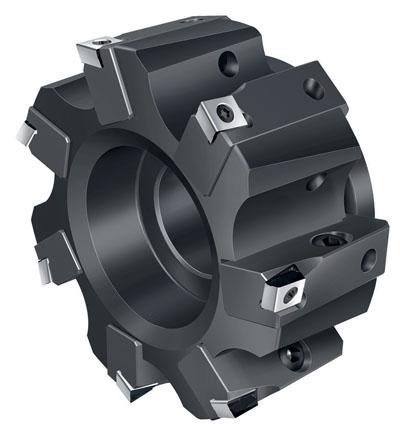
Walter has introduced two new indexable insert cartridges for the Walter F2010 facemill. These cartridges, the FR751M and FR752M, bring the flexibility and performance of Walter BLAXX tangential indexable inserts to the Walter F2010 facemill. The family of indexable milling tools, characterized by precision and reliability, includes shoulder, helical and slitting mills.
Thanks to the high level of accuracy of their precision ground inserts with their Tiger-tec-Silver cutting material, together with high precision tool bodies, users of Walter BLAXX milling tools can achieve feed rate increases of up to 30 percent and often no longer require a separate finishing tool.
The FR751M and FR752M cartridges bring numerous benefits. For instance, the Walter BLAXX shoulder mill produces precise, almost step-free 90° shoulders. That system is only available for tool diameters up to 6.30" (160mm). The F2010 face mill, equipped with the FR751M or FR752M cartridge, can now bring this technology up to a diameter of 12.40" (315mm). In addition, the F2010 can now be used for fine finishing because the indexable inserts can be adjusted axially with micrometer precision.
These inserts come in two geometry variants: the L55T, a universal geometry that can be used on most materials, and the L85T, which has a particularly sharp cutting edge for machining aluminum.
Contact Details
Related Glossary Terms
- facemill
facemill
Milling cutter for cutting flat surfaces.
- feed
feed
Rate of change of position of the tool as a whole, relative to the workpiece while cutting.
- finishing tool
finishing tool
Tool, belt, wheel or other cutting implement that completes the final, precision machining step/cut on a workpiece. Often takes the form of a grinding, honing, lapping or polishing tool. See roughing cutter.
- gang cutting ( milling)
gang cutting ( milling)
Machining with several cutters mounted on a single arbor, generally for simultaneous cutting.
- gang cutting ( milling)2
gang cutting ( milling)
Machining with several cutters mounted on a single arbor, generally for simultaneous cutting.
- indexable insert
indexable insert
Replaceable tool that clamps into a tool body, drill, mill or other cutter body designed to accommodate inserts. Most inserts are made of cemented carbide. Often they are coated with a hard material. Other insert materials are ceramic, cermet, polycrystalline cubic boron nitride and polycrystalline diamond. The insert is used until dull, then indexed, or turned, to expose a fresh cutting edge. When the entire insert is dull, it is usually discarded. Some inserts can be resharpened.
- micrometer
micrometer
A precision instrument with a spindle moved by a finely threaded screw that is used for measuring thickness and short lengths.
- milling
milling
Machining operation in which metal or other material is removed by applying power to a rotating cutter. In vertical milling, the cutting tool is mounted vertically on the spindle. In horizontal milling, the cutting tool is mounted horizontally, either directly on the spindle or on an arbor. Horizontal milling is further broken down into conventional milling, where the cutter rotates opposite the direction of feed, or “up” into the workpiece; and climb milling, where the cutter rotates in the direction of feed, or “down” into the workpiece. Milling operations include plane or surface milling, endmilling, facemilling, angle milling, form milling and profiling.
- milling machine ( mill)
milling machine ( mill)
Runs endmills and arbor-mounted milling cutters. Features include a head with a spindle that drives the cutters; a column, knee and table that provide motion in the three Cartesian axes; and a base that supports the components and houses the cutting-fluid pump and reservoir. The work is mounted on the table and fed into the rotating cutter or endmill to accomplish the milling steps; vertical milling machines also feed endmills into the work by means of a spindle-mounted quill. Models range from small manual machines to big bed-type and duplex mills. All take one of three basic forms: vertical, horizontal or convertible horizontal/vertical. Vertical machines may be knee-type (the table is mounted on a knee that can be elevated) or bed-type (the table is securely supported and only moves horizontally). In general, horizontal machines are bigger and more powerful, while vertical machines are lighter but more versatile and easier to set up and operate.

